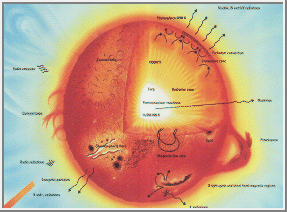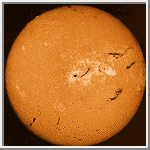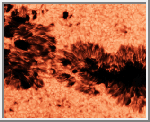 Sun
Sun Sun
Sun

The Sun is the most prominent feature in our solar system. It is the largest object and contains approximately 98% of the total solar system mass. One hundred and nine Earths would be required to fit across the Sun's disk, and its interior could hold over 1.3 million Earths. The Sun's outer visible layer is called the photosphere and has a temperature of 6,000°C (11,000°F). This layer has a mottled appearance due to the turbulent eruptions of energy at the surface.
Solar energy is created deep within the core of the Sun. It is here that the temperature (15,000,000° C; 27,000,000° F) and pressure (340 billion times Earth's air pressure at sea level) is so intense that nuclear reactions take place. This reaction causes four protons or hydrogen nuclei to fuse together to form one alpha particle or helium nucleus. The alpha particle is about .7 percent less massive than the four protons. The difference in mass is expelled as energy and is carried to the surface of the Sun, through a process known as convection, where it is released as light and heat. Energy generated in the Sun's core takes a million years to reach its surface. Every second 700 million tons of hydrogen are converted into helium ashes. In the process 5 million tons of pure energy is released; therefore, as time goes on the Sun is becoming lighter.

The chromosphere is above the photosphere. Solar energy passes through this region on its way out from the center of the Sun. Faculae and flares arise in the chromosphere. Faculae are bright luminous hydrogen clouds which form above regions where sunspots are about to form. Flares are bright filaments of hot gas emerging from sunspot regions. Sunspots are dark depressions on the photosphere with a typical temperature of 4,000°C (7,000°F).
The corona is the outer part of the Sun's atmosphere. It is in this region that prominences appears. Prominences are immense clouds of glowing gas that erupt from the upper chromosphere. The outer region of the corona stretches far into space and consists of particles traveling slowly away from the Sun. The corona can only be seen during total solar eclipses. (See Solar Eclipse Image).
The Sun appears to have been active for 4.6 billion years and has enough fuel to go on for another five billion years or so. At the end of its life, the Sun will start to fuse helium into heavier elements and begin to swell up, ultimately growing so large that it will swallow the Earth. After a billion years as a red giant, it will suddenly collapse into a white dwarf -- the final end product of a star like ours. It may take a trillion years to cool off completely.

Mass (kg) ......................................... 1.989e+30
Mass (Earth = 1) .................................... 332,830
Equatorial radius (km) .............................. 695,000
Equatorial radius (Earth = 1) ........................ 108.97
Mean density (gm/cm^3) ................................ 1.410
Mean distance from - (km) ................................. 0
Rotational period (days) .............................. 25-36*
Escape velocity (km/sec) ............................. 618.02
Luminosity (ergs/sec) .............................. 3.827e33
Magnitude (Vo) ........................................ -26.8
Mean surface temperature ............................ 6,000°C
Age (billion years) ..................................... 4.5
Principal chemistry
Hydrogen .......................................... 92.1%
Helium ............................................. 7.8%
Oxygen ........................................... 0.061%
Carbon ........................................... 0.030%
Nitrogen ........................................ 0.0084%
Neon ............................................ 0.0076%
Iron ............................................ 0.0037%
Silicon ......................................... 0.0031%
Magnesium ....................................... 0.0024%
Sulfur .......................................... 0.0015%
All others ...................................... 0.0015%
* The Sun's period of rotation at the surface varies from approximately 25 days at the equator to 36 days at the poles. Deep down, below the convective zone, everything appears to rotate with a period of 27 days.

 Eclipse & Sun Movies
Eclipse & Sun Movies
 Sun Prominence
(GIF, 261K;
JPEG, 203K;
TIF, 6M)
Sun Prominence
(GIF, 261K;
JPEG, 203K;
TIF, 6M)
This image was acquired from NASA's Skylab space station on December 19,
1973. It shows one of the most spectacular solar flares ever recorded,
propelled by magnetic forces, lifting
off from the Sun. It spans more than 588,000 km (365,000 miles)
of the solar surface.
In this photograph,
the solar poles are distinguished by a relative absence of supergranulation
network, and a much darker tone than the central portions of the disk.
(Courtesy NASA)
 Sources of the Solar Wind?
(JPEG, 117K;
caption)
Sources of the Solar Wind?
(JPEG, 117K;
caption)
"Plumes" of outward flowing, hot gas in the
Sun's atmosphere may be one source of the solar "wind" of charged particles.
These images, taken March 7, 1996, by the Solar and Heliospheric Observatory
(SOHO), show (top) magnetic fields on the sun's surface near the south solar
pole; (middle) an ultraviolet image of the 1 million degree plumes from the same
region; and (bottom) an ultraviolet image of the "quiet" solar atmosphere closer
to the surface.
(Courtesy ESA/NASA)
 The Unquiet Sun
(JPEG, 225K;
caption)
The Unquiet Sun
(JPEG, 225K;
caption)
This sequence of images of the the Sun in ultraviolet
light was taken by the Solar and Heliospheric Observatory (SOHO) spacecraft on
February 11, 1996 from its unique vantage point at the "L1" gravity neutral point 1
million miles sunward from the Earth. An "eruptive prominence" or blob of
60,000°C gas, over 80,000 miles long, was ejected at a speed of at least
15,000 miles per hour. The gaseous blob is shown to the left in each image.
These eruptions occur when a significant amount of cool dense plasma or ionized
gas escapes from the normally closed, confining, low-level magnetic fields of
the Sun's atmosphere to streak out into the interplanetary medium, or
heliosphere. Eruptions of this sort can produce major disruptions in the near
Earth environment, affecting communications, navigation systems and even power
grids.
(Courtesy ESA/NASA)
 A New Look at the Sun
(JPEG, 78K)
A New Look at the Sun
(JPEG, 78K)
This image of 1,500,000°C gas in the Sun's thin, outer atmosphere (corona)
was taken March 13, 1996 by the Extreme Ultraviolet Imaging Telescope onboard
the Solar and Heliospheric Observatory (SOHO) spacecraft. Every feature in the
image traces magnetic field structures. Because of the high quality instrument,
more of the suttle and detail magnetic features can be seen than ever before.
(Courtesy ESA/NASA)
 X-Ray Image
(GIF, 174K;
JPEG, 36K)
X-Ray Image
(GIF, 174K;
JPEG, 36K)
This is an X-ray image of the Sun obtained
on February 21, 1994. The
brighter regions are sources of increased X-ray emissions.
(Courtesy Calvin J. Hamilton, and Yohkoh)
 Solar Disk in H-Alpha
(GIF, 149K;
JPEG, 34K)
Solar Disk in H-Alpha
(GIF, 149K;
JPEG, 34K)
This is an image of the Sun as seen in
H-Alpha.
H-Alpha is a narrow wavelength of red light that is emitted and
absorbed by the element hydrogen.
(Courtesy National Solar Observatory/Sacramento Peak)
 Solar Flare in H-Alpha
(GIF, 147K;
JPEG, 38K)
Solar Flare in H-Alpha
(GIF, 147K;
JPEG, 38K)
This is an image of a solar flare as seen in
H-Alpha.
(Courtesy National Solar Observatory/Sacramento Peak)
 Solar Magnetic Fields
(GIF, 170K;
JPEG, 33K)
Solar Magnetic Fields
(GIF, 170K;
JPEG, 33K)
This image was acquired February 26, 1993. The dark regions are
locations of positive magnetic polarity and the light regions are
negative magnetic polarity.
(Courtesy GSFC NASA)
 Sun Spots
(GIF, 336K;
JPEG, 57K)
Sun Spots
(GIF, 336K;
JPEG, 57K)
This image shows the region around a
sunspot. Notice the mottled
appearance. This granulation is the result of turbulent eruptions
of energy at the surface.
(Courtesy National Solar Observatory/Sacramento Peak)
 Solar Eclipse
(GIF, 322K;
JPEG, 43K)
Solar Eclipse
(GIF, 322K;
JPEG, 43K)
This is a view of the 1977 solar eclipse.
 1991 Solar Eclipse
JPEG, local 143K;
caption)
1991 Solar Eclipse
JPEG, local 143K;
caption)
This shows the total solar eclipse of July 11, 1991 as seen from
Baja California. It is a digital mosaic is derived from five
individual photographs, each exposed
correctly for a different radius in the solar corona.
(Courtesy Steve Albers)
 1994 Solar Eclipse
(GIF, 89K;
JPEG, 121K)
1994 Solar Eclipse
(GIF, 89K;
JPEG, 121K)
The following two images were taken November 3, 1994,
as observed by the High Altitude Observatory White Light
Coronal camera from Chile.
(Courtesy HAO eclipse team)


 The Solar System
The Solar System
 Voyage to Mercury
Voyage to Mercury

